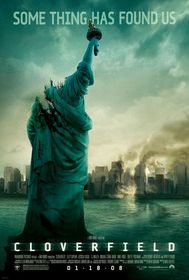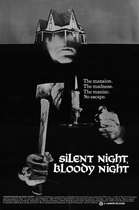Our editor-in-chief Nate Yapp is proud to have contributed to the new book Hidden Horror: A Celebration of 101 Underrated and Overlooked Fright Flicks, edited by Aaron Christensen. Another contributors include Anthony Timpone, B.J. Colangelo, Dave Alexander, Classic-Horror.com's own Robert C. Ring and John W. Bowen. Pick up a copy today from Amazon.com!
Cloverfield (2008)
It took nine years for the cinematic seeds planted by The Blair Witch Project in 1999 to come to full fruition as Cloverfield. In that near-decade, there have been very few films made that really took the revolutionary filmmaking that Blair Witch proposed – putting the camera into the hands of the characters – and ran with it. Given the low budgetary needs of such a venture and the insane profits reaped by Blair Witch, this fact is somewhat surprising. Perhaps we needed YouTube, and the rise in self-documentation that came with it, for the milieu to be right for another high-profile attempt at the genre. Perhaps we needed a national catastrophe like 9/11 to suggest the right story. Perhaps we needed both. I think we’re just lucky that one day while doing a promotional tour in Japan, Cloverfield producer JJ Abrams wandered into a toy store that was stuffed to the gills with Godzilla swag and wandered back out with a desire to do his own monster movie, because that monster movie rocks.
Usually I take some time to relay the plot here, but I’d rather relate a conversation that Classic-Horror’s own Julia Merriam had with a co-worker:
JULIA: I’m probably going to see Cloverfield tonight.
CO-WORKER: Oh I’ve heard of that. What’s it about?
JULIA: A giant monster attacks New York.
CO-WORKER: And?
JULIA: What else do you need?
Indeed, what else do you need? I love “giant monster on the rampage” films more than is reasonable. Most of them, however, take a high-level view of the proceedings, following the monster as a main character, as well as a few select humans who will be somehow instrumental to the monster’s eventual defeat. The real victims are seen fleetingly from above, running through the streets and looking very much like ants ready for squishing. Being a person who has squished an ant or two in my lifetime, I can’t say that I don’t sympathize a little with the monster in these movies when he takes the opportunity. This particular narrative perspective isn’t a liability of the format, but one of its primary pleasures. Still, it has a tendency to reduce the human factor, negating the emotional bonds formed with the victims. As such, most colossal creature carnage-fests remain firmly in the realm of science fiction/fantasy rather than horror.
Not so with Cloverfield, which brings wanton destruction back to the streets, so to speak. The details of how good-natured, slightly dim schlub Hud (T.J. Miller) ends up video-recording his friends’ attempt to flee the chaos after a giant “thing” attacks Manhattan aren’t really important (although the film spends a good chunk of time with him before the monster shows, but it’s a clever ploy to build anticipation and familiarize us with the characters). What’s important is that his camera is always on and we get to see how the “normal” people react to getting squished. Suddenly, every moment of monster movie glee that we had during moments of property destruction is flipped on its head. That bridge had somebody’s brother on it. Someone’s best friend lives in that building that was smacked to one side. The ants have lives. The ants have mothers who need to be called and informed. To borrow a trite action movie line, “This s**t just got real.”
Well, mostly real, anyway. Unlike Blair Witch, where the actors really did all the filming, Cloverfield has a credited camera operator, Robert Reed Altman, a veteran of such action-packed television shows as “Alias” and “Lost”. Altman, incidentally, is the son of the late director Robert Altman, who might have been amused (or possibly horrified) to see that his own fly-on-the-wall approach to filmmaking had mutated into an exercise in ants-on-the-ground. That a professional is merely simulating the work of an amateur is to the benefit of the film. In this way, director Matt Reeves and cinematographer Michael Bonvillain can more closely control the impact of each shot, bringing in the right visual at the right time. It is to their credit that Cloverfield never loses the thrilling promise of its premise, and it’s to Altman’s credit that the shots are always framed just incorrectly enough that we never doubt that fumbling, fictional Hud is the man behind the camera.
I do my best to keep other criticism out of my reviews – I’m reviewing the movie, not other reviews of the movie – but I have to politely disagree with some of the negativity being directed at Drew Goddard’s script. Some people find the dialogue trite and the characters too frequently taking idiotic risks. Certainly our leads have a tendency to repeat themselves (“What was that thing?” “Oh my god oh my god”) and they don’t think things through, but these are pretty ordinary people, all things considered, and generally not prepared for extraordinary circumstances. They panic. They freak out. They do the wrong thing and they say the stupid thing while doing it. They’re not the heroes of this tale – they’re the collateral damage. I can think of another film featuring a similar group of survivors – Night of the Living Dead1. That film worked – and so does this one. Our protagonists even manage some wit towards the end, once they’ve become somewhat inured to their predicament (I laughed out loud as Hud described the “thing” to a new member of the group in simple but accurate terms). What Goddard sacrifices in terms of cleverness and hipness is worth it for the raw, riveting “now-ness” of the experience.
Ah, but what of the monster? While the approach that Cloverfield takes would probably allow the film to skimp by on a fairly generic Godzilla clone, Abrams and company are having none of that. Their monster, a massive quadraped with a scaly back and an angry, fish-shaped head, seems to take its inspiration from HP Lovecraft’s Deep Ones2, although the similarities end with its appearance and possible oceanic origins. Lovecraft’s creatures were articulate, and more concerned with worship and cross-species breeding (as seen in “The Shadow Over Innsmouth”) than municipal devastation. Still, it’s an impressive creature all the same, with some equally impressive CGI (by Tippett Studio) behind it. Reeves and Goddard are careful to reveal the behemoth in stages – a fleeting, incoherent shape here, a tail there – eventually building up to its full majesty, which is pretty damned majestic in a horrifying sort of way.
There are also smaller, equally menacing terrors along the way. In one particularly memorable sequence, our heroes are beset by dog-sized parasites that have fallen off the larger monster. Hud and his friends are making their way down a dark subway tunnel to try to circumvent the destruction on the surface. A weak spotlight on the camcorder allows us to see the characters, but not much else. One of the characters lets out a cry of disgust – all the rats in the tunnel are scampering in a unified direction. Realizing that it’s never a good thing when the rats are on the run, the group peers into the darkness behind them. While they can hear clicking noises emanate from some undetermined distance, the camcorder light isn’t powerful enough to give them any clue as to the source. Rob (the camera’s owner, played by Michael Stahl-David) helps Hud find the night vision, and not a moment too soon, because the parasites are right there. It’s a beautiful moment of suspense that uses the first-person perspective to unite the characters’ unease with our own while using our separation from the events to allow us to figure out enough to establish the necessary dramatic irony (we figure out that the clicking noises are probably the parasites – which we’ve seen before – but the characters are too tired and freaked out to make the connection).
Unfortunately, the well-developed suspense in the subway tunnel is undercut by the fact that the attack itself is somewhat incomprehensible, ironically due to the film’s single-camera approach. Hud is understandably freaked out and the camera whips around frantically before he is finally knocked down by one of the parasites. This is great to relay Hud’s own emotional state but it doesn’t manage to tell us much about what’s actually going on, which is something similar sequences in other parts of the film are actually pretty good about. It almost makes one think the whole “parasite” concept is a wash, except that later they provide a couple really great moments (which you’ll have to see the movie to discover).
I wonder if I’ll ever be able to watch a giant monster trash a major metropolitan area again without thinking about the plight of Hud and his friends, caught in the midst of a terrible battle they didn’t ask for or deserve. That’s the kind of movie Cloverfield is. Where its cinematographic predecessor Blair Witch Project promised a revolution in how we make horror movies, Cloverfield actually delivers one over how we view them. Let me tell you – a change of mind never felt so awesome.
- Coincidentally (or not), George A. Romero's next Dead film also uses the first-person camera perspective to follow a group attempting to survive the very beginning of the zombie outbreak.
- Cloverfield's viral marketing (which almost deserves a review of its own) includes a website for a beverage called Slusho, which is reportedly manufactured from an ingredient found deep at the bottom of the ocean. Other viral websites suggest the method by which the creature might have been awoken. Poke around online and you'll find enough evidence to formulate your own crazed theory about the origins of Cloverfield's unnamed beastie.








